Charley
Straight
Pianist, Composer, Band Leader
By Albert Haim
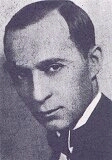 Charley
Straight
Charley
Straight
Introduction.
Charles
Theodore Straight, known as “Charley”
Straight, was
born on January, 6, 1891 in Chicago, Illinois. The 1910 US Census finds
Charley, listed as Chas. Jr., born in Jan 1891 and living at 5742
Armour Avenue, Chicago, Cook County, Illinois with his father Chas.,
born in Ohio in June 1864 and his mother Anna, born in August 1875 in
Sweden. Following his graduation from
Wendell
Phillips High School (built in 1904 and designated
as a Chicago landmark in
2003) in 1909, Charley, who by
all accounts
was

Wendell
Phillips High School, Chicago, Illinois
a first-class pianist,
began a
31-year career as accompanist, performer, composer, and bandleader.
Charley Straight: Pianist, Composer, and
Producer of Piano Rolls.
Charley
Straight’s first professional job
was with Eugene “Gene” Greene (1877-1930), the vaudeville artist known
as “The
Ragtime King.” Greene and Straight wrote much of the material they
performed.
Their
most popular number was “King of the Bungaloos,”
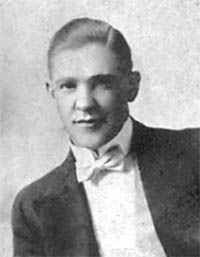 first
recorded for
Columbia on February 17, 1911. “King of the Bungaloos,” as performed by
Greene,
included non-sense syllables, perhaps the first example of scatting on
record. [1]
first
recorded for
Columbia on February 17, 1911. “King of the Bungaloos,” as performed by
Greene,
included non-sense syllables, perhaps the first example of scatting on
record. [1]
In 1912-1913, Greene and Straight performed
in England and recorded about 64 sides for Pathe. While in England,
they had a command performance for the King and Queen. [2] Ian
Whitcomb describes the team, "Greene scat singing his way nightly
through his big American hit 'King of the Bungalow' to the car-chase
rag
piano of Charlie [sic] Straight of Tin Pan Alley." [3] Greene and Straight sailed home
on the S.S. Kaiser Wilhelm II from
Southampton on March 5, 1913, and arrived in New York on March 12,
1913.
[4] The ship manifest describes
Gene Greene
Charles Straight as male, single,
age 22, born in Chicago, Illinois, address in the US Champlain Ave.,
Chicago, Illinois. It is curious that the birth date is given as
January 15, 1890, but the age as 22. Eugene Greene is described as
male, married, age 32, born in Aurora, Illinois on June 9, 1881 with
residence in the US at 3752 Love Avenue, Chicago, Illinois.
According
to US census data, Charley was
married in 1913. Soon after, he and Greene went to Australia where they
stayed for about six months, returning to the US in 1914. Greene
and Straight spent most of late 1913 performing in the Tivoli
Theatre
in
Melbourne.

Tivoli
Theatre,
Melbourne, Australia
In
1914-1916 Straight was based
in New York and published songs and rags with M. Witmark and Sons and
with Jerome H. Remick and Company. His first rag, "Humpty Dumpty," was published by Witmark
in January 1914. Remick published three of his rags in quick
succession, "Let's Go" and "Red Raven Rag" at the end of 1915, and "Hot
Hands" in February 1916. As his reputation grew, Charley
Straight was
sought by various companies. He returned
to Chicago and first made piano rolls for
Rolla Artis, a
 subsidiary
of the Rudolph Wurlitzer Company, under the name of
Billie/Billy King. It
is noteworthy that the cover of the Rolla Artist piano roll # 50298,
“Mity-Nice” gives Charley Straight as the composer and Billie King as
the performer. Of course, they are one and the same.
In 1917, Straight went to work for the “Imperial Player
Roll Company” in Chicago as performer, arranger, and musical director.
He recorded numerous piano rolls of novelty rags for Imperial as well
as for
the rival company QRS. It turns
out that QRS developed the
marking
piano, a machine that produced master rolls for player pianos by
recording
actual performances. The first roll that QRS
subsidiary
of the Rudolph Wurlitzer Company, under the name of
Billie/Billy King. It
is noteworthy that the cover of the Rolla Artist piano roll # 50298,
“Mity-Nice” gives Charley Straight as the composer and Billie King as
the performer. Of course, they are one and the same.
In 1917, Straight went to work for the “Imperial Player
Roll Company” in Chicago as performer, arranger, and musical director.
He recorded numerous piano rolls of novelty rags for Imperial as well
as for
the rival company QRS. It turns
out that QRS developed the
marking
piano, a machine that produced master rolls for player pianos by
recording
actual performances. The first roll that QRS
released based on a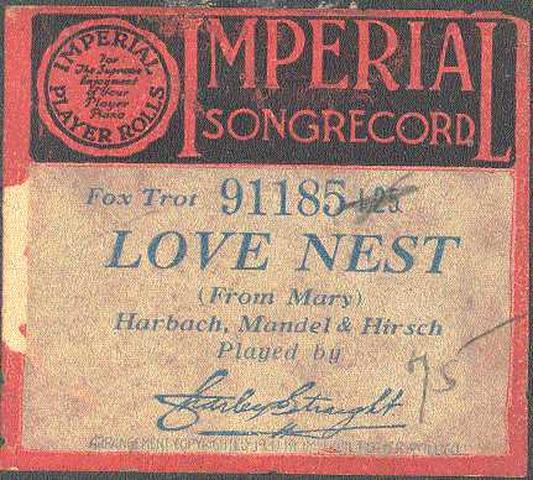 recording in
the marking piano was “Pretty Baby” in 1912 by Charley
Straight. [6] Some of the piano rolls made by
Straight for
Imperial were "I'll Come Sailing Home To You" (1917), "Red Rose"
(1918), "Everybody Wants The Key To My Cellar" (1919), "Love Nest"
(1920), "Carolina Rolling Stone" (1921). The 1919 QRS roll of Charley
Straight's "S'more" was mentioned in the June 7, 1919 issue of "Music
Trade Indicator." Straight is described as "the man who is putting pep
into piano rolls." [7]
recording in
the marking piano was “Pretty Baby” in 1912 by Charley
Straight. [6] Some of the piano rolls made by
Straight for
Imperial were "I'll Come Sailing Home To You" (1917), "Red Rose"
(1918), "Everybody Wants The Key To My Cellar" (1919), "Love Nest"
(1920), "Carolina Rolling Stone" (1921). The 1919 QRS roll of Charley
Straight's "S'more" was mentioned in the June 7, 1919 issue of "Music
Trade Indicator." Straight is described as "the man who is putting pep
into piano rolls." [7]
On
May 31, 1917, Charles Theodore Straight
registered for the draft. As seen in the image of the draft card, [8]
when
asked
“Do you claim exemption from the draft?” Straight responded, “Yes, only
on acct
wife and baby.” His wife, Clara in the
1920 US Census and Sadie in the 1930 US Census (apparently, the same
person), was
one year younger than Charley, and the baby, Virginia, was about two
years old
at the time. Another daughter, June was born in 1918. In his
draft card, Straight gives “Waterson, Berlin
and Snyder of 81 Randolph Street” as his employer. Waterson, Berlin and
Snyder was a publishing company created in 1911 in New York when Henry
Waterson and Ted Snyder (the composer of “The Sheik of Araby” and other
hits) decided to take Irving Berlin as a partner when he composed his
mega-hit “Alexander’s Ragtime Band”. From May 1914 on, the company’s
headquarters were in New York City at 224 West Forty-seventh St, in the
Strand Theater Building. The company also had a subsidiary office in
Chicago, first at 43 Monroe St, and then at 81 Randolph St. [9]
Evidently,
before he joined the “Imperial Player Roll Company”, Straight worked
for a time with Waterson, Berlin and Snyder. This information was not
known prior to the discovery of his draft registration card.
In
1919, Straight hired Roy Bargy as editor
of popular songs for the production of piano rolls as well as composer
of
novelty/rag songs for the Imperial Roll Company. At the urging of
Charley Straight, Bargy composed,
in 1920, “Piano
Syncopations” a set of eight tunes, the most famous being “Pianoflage.” Six of
them were produced as piano rolls in 1920 and published as sheet music
in 1922. Roy Bargy recorded the six tunes for Victor in 1922 and
1924.
Although the subject is controversial, it is likely that both Roy Bargy
and
Charley Straight composed “Rufenreddy,’” one of the tunes in the “Piano
Syncopation” series. “Perfessor” Bill Edwards writes, “The actual
parentage of
this piece will likely remain obscured to some degree, since Bargy's
collaborator, Charley Straight, more or less may have let Bargy take
credit
when the piano rolls of the Eight Piano Syncopations were transcribed
into
sheet music form. It is likely that Straight wrote the bulk of the
composition
in 1918, and Bargy added many of his individual touches to it in the
performance, the end result being that there is some of each of them
within.”
[10] It is noteworthy that “Rufenreddy” is
listed in the ASCAP data base with Charley Straight as the sole
composer. On
the other hand, “K’nice and K’nifty”, another of the tunes in the
“Piano
Syncopation” series, is listed as co-composed by Charley Straight and
Roy Bargy. Jim
Jams is credited to Roy F. Bargy, while the remaining tunes are not
listed in the ASCAP data base. Some
of the piano rolls issued by Imperial, for example, "Swanee" (1919; the
Al Jolson hit composed by George Gershwin), "Kismet" (1920),
"Whispering" (1921), were played by the piano
duet of Straight and Bargy. Piano rolls played by duets were not
uncommon. Charley Straight also made piano rolls with, among
others, Jack Clyde, Max Kortlander, William Hartman, Arnold
Johnson, and Burt Franklin.
being “Pianoflage.” Six of
them were produced as piano rolls in 1920 and published as sheet music
in 1922. Roy Bargy recorded the six tunes for Victor in 1922 and
1924.
Although the subject is controversial, it is likely that both Roy Bargy
and
Charley Straight composed “Rufenreddy,’” one of the tunes in the “Piano
Syncopation” series. “Perfessor” Bill Edwards writes, “The actual
parentage of
this piece will likely remain obscured to some degree, since Bargy's
collaborator, Charley Straight, more or less may have let Bargy take
credit
when the piano rolls of the Eight Piano Syncopations were transcribed
into
sheet music form. It is likely that Straight wrote the bulk of the
composition
in 1918, and Bargy added many of his individual touches to it in the
performance, the end result being that there is some of each of them
within.”
[10] It is noteworthy that “Rufenreddy” is
listed in the ASCAP data base with Charley Straight as the sole
composer. On
the other hand, “K’nice and K’nifty”, another of the tunes in the
“Piano
Syncopation” series, is listed as co-composed by Charley Straight and
Roy Bargy. Jim
Jams is credited to Roy F. Bargy, while the remaining tunes are not
listed in the ASCAP data base. Some
of the piano rolls issued by Imperial, for example, "Swanee" (1919; the
Al Jolson hit composed by George Gershwin), "Kismet" (1920),
"Whispering" (1921), were played by the piano
duet of Straight and Bargy. Piano rolls played by duets were not
uncommon. Charley Straight also made piano rolls with, among
others, Jack Clyde, Max Kortlander, William Hartman, Arnold
Johnson, and Burt Franklin.
On November 24, 1919, the “Imperial Three,”
a trio consisting of Paul Biese doubling on violin and tenor saxophone,
Roy Bargy
on piano, and Charley Straight on piano made a test recording for
Victor. About
a month later the trio issued two sides on Emerson, "O (Oh!) (Intro.
Just Like the Rose)" and "Nobody Knows (And Nobody Seems to Care)
(Intro. I Left My Door Open And My Daddy Walked Out). [11]
The 1920 US Census finds Charley Straight living at 746 Garfield Blvd.
in Chicago, Illinois, with his wife Clara, age 29, and daughters
Virginia, age 5, and June, age 2. Charley gives his profession as
"manager of piano firm."
Roy Bargy left Imperial in 1921 and joined the Benson Orchestra of
Chicago as pianist and leader. Edgar A. Benson was an impresario who
managed several bands in Chicago in the 1920s. Charley Straight
introduced Roy Bargy to Benson, who had started his orchestra
in 1920. One recording of the Benson orchestra featured Roy Bargy
and Charley Straight as a
piano duet. Bargy and Straight must have been very well known: it is
significant that both pianists are given credit on the record label of
"Ten Litttle Fingers and Ten Little Toes," Victor 18871, recorded on
January 31, 1922.
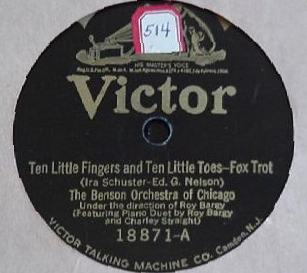
Charley
Straight: Orchestra Leader.
In 1922, Charley Straight left the Imperial
Roll Company and led a band at the Rendezvous Café in Chicago
where he
stayed, on and off,
for about four years. The Rendezvous Café was located in the
second floor of
the Rienzi Hotel on West Diversey Parkway near the corner of North
Clark
Street. It was first known as Rienzi Gardens, but changed its name to
Rendezvous Café in 1923. Other bands that followed Charley
Straight at the
Rendezvous were Mike Speciale, Louis Panico (formerly with Isham Jones)
and Ben
Pollack. [12]

The Charley Straight
Rendezvous Orchestra in 1925
Charley Straight
at the piano
Hannah and
Dorothea Williams standing next to the piano
In
1923, Charley Straight and His Orchestra
began recording for Paramount. The first recording, in June 1923, was
“Buddy’s Habit,”
a composition
by Straight himself. “Buddy’s Habit” was recorded a few months later,
in quick
succession, by King Oliver’s Creole Jazz Band, the Midway Dance
Orchestra (an
Elmer Schoebel unit), and the Bucktown Five. Commenting on this
recording by
Straight’s band, Mark Berresford writes, “The ease with which the whole
sax
section take a unison break at fast tempo on “Buddy’s Habits” is quite
staggering – a feat few bands black or white could match at this time.”
[13] During
the period June-December 1923, the Charley Straight Orchestra waxed
fourteen
sides
for Paramount. Some of these were issued by Claxtonola, Puritan,
Resona,
Triangle and Broadway as the “Frisco Syncopators,” the “Manhattan
Imperial
Orchestra,” the “Harmograph Dance Orchestra,” the “Broadway Melody
Makers”
and “The Rendezvous Dance Orchestra.” The last recording for
Paramount
was "Forgetful Blues, from December 1923. Although the Charley Straight
Orchestra
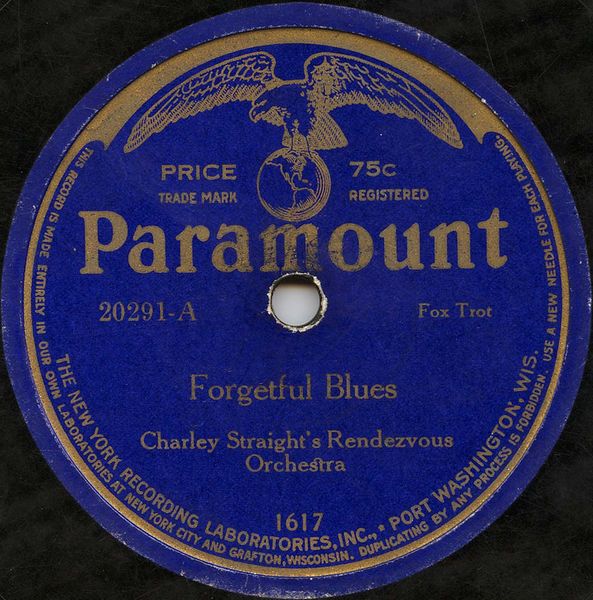
was a dance band,
the recordings of 1923
consisted of very jazzy arrangements.
The
band was silent, as far as recordings are concerned, from December 1923
to
March 1926. Beginning in March 1926 and ending in August 1928, the
Charley
Straight Orchestra recorded 34 sides for Brunswick. Some of these were
issued
under the name of “The Clevelanders” and on Vocalion as the “Tuxedo
Orchestra.” One pair of recordings, "Minor Gaffe/Hobo Prayers," was
issued in June 1926 on Vocalion 15169 as per "The Tennessee Tooters."
But this is, in fact, the working Charley Straight Orchestra of 1926.
The Tennessee Tooters was a studio band that recorded 22 sides between
December 1923 and September 1926 with such excellent musicians as Red
Nichols, Rube Bloom, Miff Mole, and Joe Tarto. The recording
of "Too Busy" from May 23, 1928 by Charley Straight and His
Orchestra is
of particular interest. Brian Rust notes, "This
is not the recording of TOO BUSY recalled by Mr. Rex Downing
(trombonist with the Coon-Sanders Nighthawks) in the July-August issue
of RECORD RESEARCH, p. 5, as being made by this orchestra., including
himself on trombone and Bix Beiderbecke-c. Perhaps some unissued record
was made under Charley Straight's direction during early July 1928,
when the Paul Whiteman Orchestra, with Bix, was playing an engagement
in Chicago." [11]
In 1926, the band travelled for the Music
Corporation of America (MCA) circuit of Midwest venues and had a long
engagement at the Muehlebach Hotel in Kansas City.
MCA had been founded
in the
early 1920s by Jules Caesar Stein, a medical doctor. Other bands under
contract
with MCA were some of the best-known in the Midwest –Paul Biese, Coon
Sanders
Nighthawks, Ted Weems, Isham Jones, Zez Confrey, Don Bestor, Ray
Miller, Jack
Crawford. MCA
even arranged out of town tours for King Oliver. The Hotel Muehlebach Plantation Grill was the site where
the
Coon-Sanders
Nighthawks gained
national recognition through their late
night broadcasts. During
1922-1926, the Straight band also
appeared for special occasions at the Blackhawk Restaurant, one of the
most
desirable venues in Chicago. Charley Straight’s band was at the
Blackhawk for two weeks in September 1926, just before
the
Coon-Sanders
Nighthawks opened there and began a regular radio broadcast
over WGN. [12]
<>
Charley
Straight
then had an engagement at the Midnight Frolics at 18 E. 22nd Street.,
Chicago. The Midnight Frolics had opened in 1921 in the site previously
occupied
by Freiberg's Dance Hall. The Dance Hall had been operated by Ike
Bloom, the King of Brothels, from 1895 until 1914. Beginning in
1921, the Midnight Frolics hired some of the best bands. The shows at
the
Frolics were lavish, with several acts –dancers, singers, comedians, a
master
of ceremonies who also sang and did comedy (Joe E. Lewis began his
career as MC
in 1925 or 1926 at the Frolics), and a
dance
band. The gala opening night for
Charley Straight Orchestra's engagement included, among other highly
popular performers, Sophie Tucker. The Frolics was Al Capone's favorite
night club. He had a 25 % interest in it. The Midnight Frolics was
raided by federal agents in February
1928 and
was shut down. It re-opened in the spring of 1928, again with show and
dance
music provided by Charley Straight. [12]
The Charley Straight band moved to the
Rainbo Room at 4812-36 North Clark Street in November 1929. The Rainbo Room had opened in 1922 in
the
location of the old
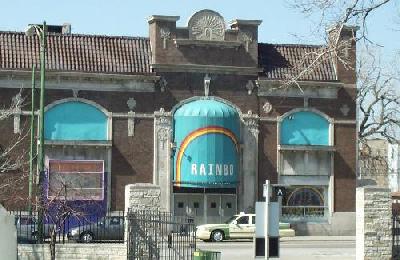
The
Rainbo Gardens Building in 2002, shortly before it was demolished
Rainbo Gardens, where Ruth Etting had appeared in
the early 1910s, and Isham Jones and His Orchestra in 1918-1920. It was at the
Rainbo Gardens that vaudevillians Ted
Healy and Moe Howard asked Larry Fine to join their comedy act
eventually to become “The Three Stooges." In 1894, the North Clark Street
site was occupied by a
small road house restaurant. As Chicago grew the area became urban, a
second floor was added to the restaurant, and a beer hall and an
outdoor dance floor were
constructed. In 1917 the place was
known as the Moulin Rouge Gardens. After the war, the Gardens were
taken over by two Chicago restaurateurs who renamed it Rainbo Gardens
(one of the new owners, Al Mann, had served during World War I with the
42nd "Rainbow" Division of the American Expeditionary
Forces.) In 1921, they redesigned the outdoor gardens and
erected a two-story building with a cocktail bar and an immense dining
room, the Rainbo Room, which featured a revolving stage to provide
continuous entertainment. The Rainbo Room could
accommodate about 2,000
diners at
a time and an additional 1,500 dancers. It was shut down in February
1928 following a raid by federal
authorities. The Rainbo Room opened under new management in November
1929 with Charley Straight's band as the main attraction for dancers
but,
shortly afterward, was forced to close because of a fire. [12]
The musical, social, and economic worlds were
changing considerably by the end of the 1920s decade, and Charley
Straight was
one of the casualties. The Music Corporation of America had dropped
Charley
Straight from his roster of musicians by 1930. The 1930 US Census finds
Charley
Straight residing at 7300 South Shore Drive, Apt. 305, Chicago, IL,
with his
wife Sadie, age 38; daughters Virginia, age 15 and June, age 12.
Charles
Straight is described as “head of the household, white, male, age 39,
married
at age 22, musician, working in a theatre.” His monthly rent is $88.15.
In spite of the great depression and
changing musical tastes, Charley Straight managed to work as a
musician
in the 1930s playing dates on weekends with success.
His band
was “one of the favorite orchestras at Chicago’s Century of Progress
in
1933-34.” [14] In 1937, he appeared in various venues as
“Charley
Straight and his Great WGN & CBS Orchestra.”
and June, age 12.
Charles
Straight is described as “head of the household, white, male, age 39,
married
at age 22, musician, working in a theatre.” His monthly rent is $88.15.
In spite of the great depression and
changing musical tastes, Charley Straight managed to work as a
musician
in the 1930s playing dates on weekends with success.
His band
was “one of the favorite orchestras at Chicago’s Century of Progress
in
1933-34.” [14] In 1937, he appeared in various venues as
“Charley
Straight and his Great WGN & CBS Orchestra.”
In 1940, in order to make ends meet,
Charley Straight took a day job as a water sampler with the
Metropolitan
Sanitary District (Chicago). Tragically, as he was working over a
manhole on
the evening of September 22, 1940, he was struck and killed by a
passing car. [2, 15]
Charley Straight and Bix Beiderbecke.
Undoubtedly, the most important
musician to play with the Charley Straight Orchestra was Leon “Bix”
Beiderbecke.
After leaving the Jean Goldkette Orchestra at the end of 1924, Bix
recorded
his own composition “Davenport Blues” in Richmond, Indiana on January
26, 1925
as “Bix Beiderbecke and His Rhythm Jugglers”
(Tommy Dorsey, Don Murray, Paul Mertz, and Tommy Gargano). Bix
then
enrolled as an unclassified student at the University of Iowa, but, as
a
consequence of being involved in a fight in a local student hangout, he
lasted
only for 18 days. Bix then spent most of the month of March 1925 in New
York
where he stayed with Red Nichols and sat with the California Ramblers.
Bix turned up in Chicago on March
23,
1925, deposited his union card with Chicago Local # 10, and soon after
was
hired by Charley Straight. The
circumstances under which Bix was hired are interesting. According to
Eddie
Condon via John Steiner, “Charley Straight had heard Bix on the
Wolverine
records and wanted Bix in his band. Charley appealed to the local board
for Bix
to come without the usual transfer penalties. Charley told them, ‘Get
me a man
as good as Bix and I won’t need Bix.’ The board allowed Bix in without
penalty.” [16] At first, Bix played with the “relief band,” the band
that
played
from 1:00 am, after the regular band ended its engagement, until 5:00
am. The
regular Charley Straight band was a 10-piece band; the relief band
consisted of
six men, cornet, trombone, reeds, brass bass, piano, and drums. The
salary that
Bix got as a member of the “relief band” was supplemented by the
members of the
main band who contributed $10 apiece a week just for the satisfaction
of having
Bix play with the main band. [16] Bix stayed with Charley Straight for
about
three
months. He left in early July 1925 to join one of the Goldkette outfits
playing
at the Lakeside Casino in Walled Lake, Michigan. While Bix was with the
Charley Straight orchestra, Red
Nichols
visited him. Red Nichols told Philip Evans on July 4, 1960, "I went to
Chicago to see Hannah Williams, who with her sister Dorothea, was
singing with the Charley Straight Orchestra. At the time, I was sweet
on
Hannah. She had been away from New York for some time and I wanted to
find out if we still had anything in common? I stayed with Bix at his
hotel. I listened to him play with the Straight band, and he escorted
me to a few places around town." [16]
< style="font-family: bookman old style;">Noted guitarist,
jazz historian/preservationist, and active member of the New Orleans
Jazz Club Edmond
"Doc" Souchon (1897-1969) attended one of the performances of the
Charley Straight band in Chicago in the Spring of 1925. In a letter to
Phil
Evans, Souchon writes, "The Rendez-vous Cafe catered to young people
and
you had to bring your own liquor (remember Prohibition?), while they
furnished
the fixin’s. You could buy an excellent dinner for a very nominal
charge and
there was an excellent dance floor. When the “big
band” went off stage to take a breather, a small group, consisting of
sax,
drums, a tuba, and a very young looking kid who doubled on piano and
cornet
continued to play for the customers. Somehow or other my wife and I
rebelled
against this small group. They didn’t give our ears a rest, and they
played
some sort of “way out” music hat we couldn’t quite grasp. I hang my
head in
shame, when I know now that the big band was none other than Charlie
[sic] Straight’s,
and the little piano-cornet virtuoso was none other than Bix. How I’ve
regretted not recognizing this great artist, how I regret not even
talking to
him! The only consolation is that there were so many other stupid fools
at the
time that felt the same we did! Now and forever on, I think of Bix as
the
greatest (next to King Oliver) and I don’t think there is any
competition
there, because the two were so entirely different. The idioms are eons
apart!”
[16]
Conclusion.
Charley
Straight’s musical legacy
consists of dozens of compositions, approximately one hundred
recordings, and dozens of piano rolls. His piano compositions are still
performed, and his records, some of which have been re-issued on CD,
[13,17] are
played on radio programs about 1920s music. Eighteen of his piano rolls
have been re-issued.
[18] Charley
Straight must be viewed, in part, as a novelty rag
composer/arranger/performer, one of several pianists in the late 1910s
and early 1920s who “took ragtime in its abstract essence as piano-roll
music and expanded it. Developing a whole system of conventions, often
based on the harmonic concepts of the Impressionists, they produced a
unique style and body of music that became at least as fully realized
as the classic rag.” [19] He has also been viewed as “an
important
figure in the
metamorphosis from ragtime to jazz,” [13] and
as the leader of one of the best dance bands in Chicago in the 1920s.
“They were an elite outfit, playing the finest hotels and clubs.” [20]
Acknowledgment. I am grateful to
Mike Meddlings who invited me to contribute a piece on Charley Straight
for his series "WWI Draft Registration Cards in
http://www.doctorjazz.co.uk/draftcards.html The present article
is an outgrowth of my contribution for the Registration Cards series.
References.
[1]
"Popular American Recording Pioneers" by
Tim Gracyk, Haworth Press, Binghamton, New York, 2000.
[2] "Southeastern
Economist," 26th
September 1940, Vol. 5, No. 3, page 1, Chicago, Illinois. Courtesy of
Robert Perry and Mike Meddings.
[3]
"Irving Berlin and
Ragtime America" by Ian
Whitcomb, Century Hutchison, London,
1987.
[4] Ellis Island Records, http://www.ellisisland.org/
[5] Quoted in "Playing
Ad Lib, Improvisatory Music in Australia : 1836-1970," by
John Whiteoak.
Currency Press Ltd., New South Wales, Australia, 1999. I am grateful to
the author for calling my attention to this reference.
[6] http://www.qrsmusic.com/downloads/pdf/om76390.pdf
[7] Quoted in "Rags and Ragtime, A Musical History" by David A Jasen
and Trebor Jay Tichenor, The Seabury Press, New York, 1978.
[8] http://www.doctorjazz.co.uk/draftcards.html#ragdccts
[9] I am grateful to a reference librarian of the Chicago Public
Library for this information.
[10]
http://www.perfessorbill.com/index2.htm
[11] The
American Dance Band Discography, 1917-1942,”
by Brian Rust. Arlington House, New Rochelle, New York, 1975.
[12] “That Toddlin’ Town. Chicago’s White Dance
Bands, 1900-1950,” by Charles A. Sengstock, Jr. University of Illinois
Press,
Urbana and Chicago, 2004.
[13]
Mark Berresford, liners, “Chicago
Rhythm,” Jazz Oracle BDW 8010.
[14] Obituary
in the September 24, 1940 issue of the
New York
Times.
[15] Robert Perry in
http://launch.groups.yahoo.com/group/EliteSyncopations/message/2654
[16] "Bix: The Leon Bix Beiderbecke Story" by Philip R. Evans and Linda
K. Evans, Prelike Press, Bakersfield, CA, 1998.
[17] "Brusnwick/Vocalion Odds & Bits," Timeless CBC-1055.
[18] "Piano Roll Artistry of Charley
Straight," Smithsonian Folkways Records
FWRBF44.
[19] "This Is Ragtime" by
Terry Waldo,
Hawthorn
Books, Inc., New York, New York, 1976.
[20] "That American Rag:
The Story of Ragtime from Coast to Coast," by David A. Jasen and Gene
Jones, Schirmer Books, New York, NY, 2000.





 recording in
the marking piano was “Pretty Baby” in 1912 by Charley
Straight
recording in
the marking piano was “Pretty Baby” in 1912 by Charley
Straight being “Pianoflage.” Six of
them were produced as piano rolls in 1920 and published as sheet music
in 1922. Roy Bargy recorded the six tunes for Victor in 1922 and
1924.
Although the subject is controversial, it is likely that both Roy Bargy
and
Charley Straight composed “Rufenreddy,’” one of the tunes in the “Piano
Syncopation” series. “Perfessor” Bill Edwards writes, “The actual
parentage of
this piece will likely remain obscured to some degree, since Bargy's
collaborator, Charley Straight, more or less may have let Bargy take
credit
when the piano rolls of the Eight Piano Syncopations were transcribed
into
sheet music form. It is likely that Straight wrote the bulk of the
composition
in 1918, and Bargy added many of his individual touches to it in the
performance, the end result being that there is some of each of them
within.”
[10] It is noteworthy that
being “Pianoflage.” Six of
them were produced as piano rolls in 1920 and published as sheet music
in 1922. Roy Bargy recorded the six tunes for Victor in 1922 and
1924.
Although the subject is controversial, it is likely that both Roy Bargy
and
Charley Straight composed “Rufenreddy,’” one of the tunes in the “Piano
Syncopation” series. “Perfessor” Bill Edwards writes, “The actual
parentage of
this piece will likely remain obscured to some degree, since Bargy's
collaborator, Charley Straight, more or less may have let Bargy take
credit
when the piano rolls of the Eight Piano Syncopations were transcribed
into
sheet music form. It is likely that Straight wrote the bulk of the
composition
in 1918, and Bargy added many of his individual touches to it in the
performance, the end result being that there is some of each of them
within.”
[10] It is noteworthy that


